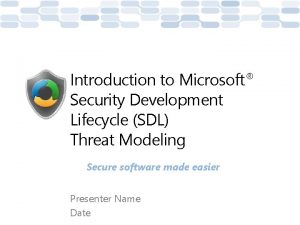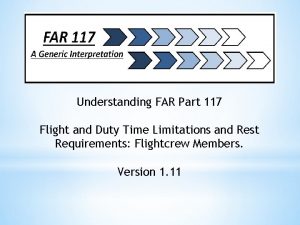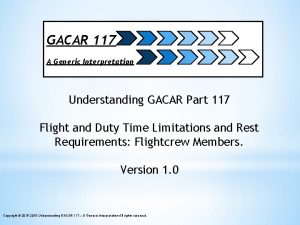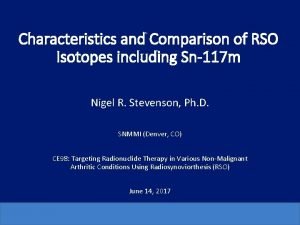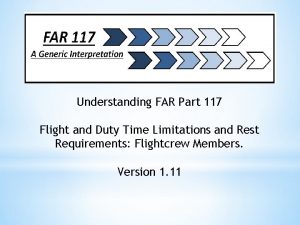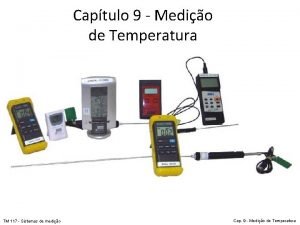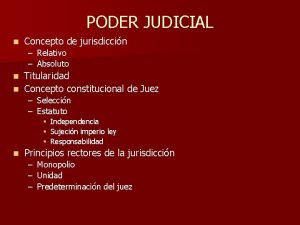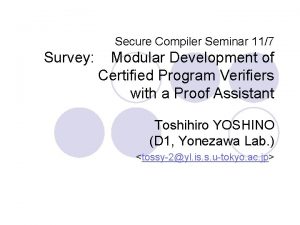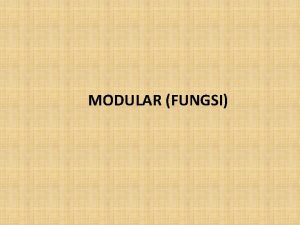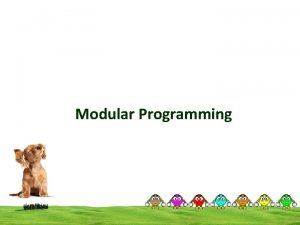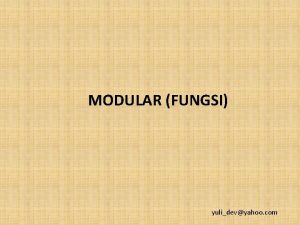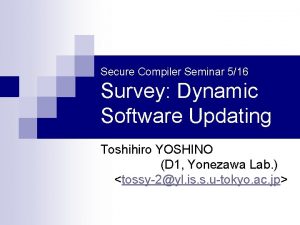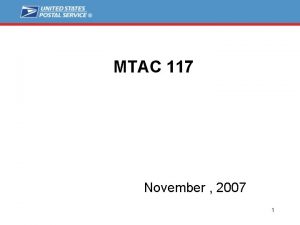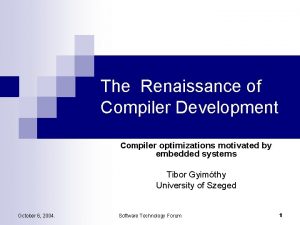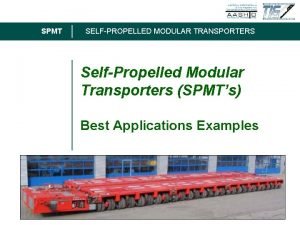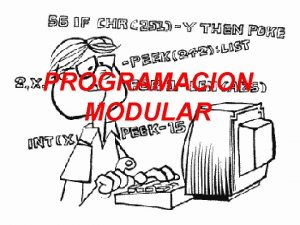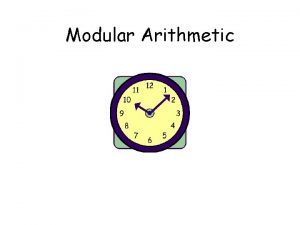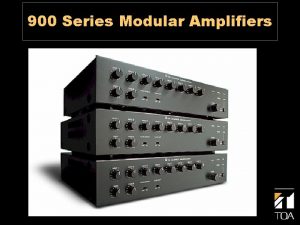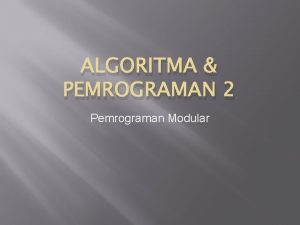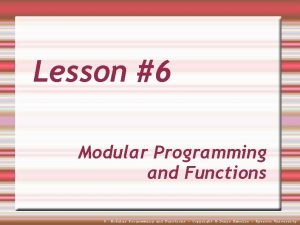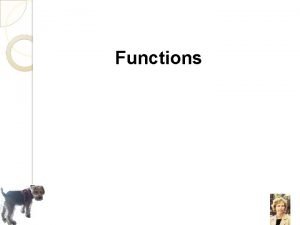Secure Compiler Seminar 117 Survey Modular Development of























![Related Work l Foundational PCC[Appel 2001] ¡ ¡ Reduce TCB and also improve flexibility Related Work l Foundational PCC[Appel 2001] ¡ ¡ Reduce TCB and also improve flexibility](https://slidetodoc.com/presentation_image_h/000f269ba18a2ee61bb3be45965cfd0b/image-24.jpg)




- Slides: 28

Secure Compiler Seminar 11/7 Survey: Modular Development of Certified Program Verifiers with a Proof Assistant Toshihiro YOSHINO (D 1, Yonezawa Lab. ) <tossy-2@yl. is. s. u-tokyo. ac. jp>

Today’s Paper l A. Chlipala (UC Berkeley). Modular Development of Certified Program Verifiers with a Proof Assistant. ICFP ’ 06. ¡ Implementation can be downloaded from web site below: ⇒ http: //proofos. sourceforge. net/

Overview of the Paper l Case study to develop a certified program verifier with Coq ¡ Verifies memory safety of x 86 machine code ¡ Its soundness is machine-checked ¡ Modular development by reusable functors l Possible to create a new verifier based on another type system with low cost

Constructing Certified Verifiers l Design and implement with Coq ¡ l Use “extraction” feature of Coq to obtain a working verifier A verifier can be formalized as: ¡ load: program -> state loads a program l ¡ ¡ The type program represents binary file format safe: state -> Prop is the safety property we wish to verify for programs [[P]] is notation for poption P l option(O’Caml) or Maybe(Haskell) for domain Prop

Constructing Certified Verifiers l Abstraction refinement by multiple stages ¡ Each stage (component) is a functor which transforms target states into source states l Later components reason at higher levels of abstraction ¡ Use Coq’s module system to implement this modular design

Formalization of x 86 Instruction Set l PCC-style formalization ¡ Subset of x 86 instruction set + ERROR instruction l l mov, jcc, … Safety ≡ ERROR is unreachable In combination with assertion, many properties can be proven ¡ Can be formalized coinductively ¡ l l Cope with infinite derivation

Types and Extraction in Coq l Basically Coq manipulates on terms of dependently-typed lambda calculus ¡A proposition is represented as a type, its proof as a term of that type l Well known as Curry-Howard isomorphism ¡ Proving step corresponds to type inference Given a goal, refine it interactively into subgoals, and eliminate holes l Rules used for these steps are called tactics l

Types and Extraction in Coq l Program extraction from Coq code In short, extraction is to erase terms of sorts other than Set ¡ Brief example: is. Even ¡ Definition is. Even : forall (n: nat), poption (even n). refine (fix is. Even (n: nat) : poption (even n) : = match n return … with | O => PSome _ _ | S (S n) => … | _ => PNone _ end); auto. Qed. let rec is. Even (n: nat) = match n with | O -> true | S (S n) -> is. Even n | _ -> false

poption: “option” for Domain “Prop” l Two constructors: PNone and PSome ¡ PSome l Literately, PSome means “P holds and I have a proof for that” and PNone “I am not sure” ¡ Can l ¡ In is given a proof of P be used as failure-monad PNone >>= _ PSome p >>= f = PNone =fp extraction, PSome corresponds to true, and PNone to false

soption l soption extends poption with a parameter ¡ Proposition about a term of domain T (of sort Set) ¡ soption, l In too, can be used as failure monad the paper’s theoretical part, written as {{ x : T | P }}

Coq’s Module System l Used to build re-usable verification components ¡ Frequent pattern: Module M 86 <: MACHINE. Definition mstate : = state. Definition minstr : = instr. … End M 86. Module Type MACHINE. Parameter mstate : Set. Parameter minit. State : mstate -> Prop. … End MACHINE. Record state : Set : = { Inductive : instr : Set : = st. Regs 32 regs 32; : … exec : … : = … Arith Inductive }. | ……. .

Module Model. Check l Provides fundamental methods of model checking ¡ Methods to prove theorems about infinite state systems through exhaustive exploration l Abstract Refine the model in each of the following stages Concrete

Module Model. Check Introduced Elements l abs. State: a set of abstract states ¡ An abstract state is managed with “hypotheses”, states that are known to be safe l l describes correspondence between machine states and abstract states ¡ l Hypothesis is used, for example, to formalize return pointer from a function Context(Γ) is deleted in extracting a verifier init is a set (actually a list) of initial states ¡ ¡ It must be a set because one real machine state may correspond to multiple abstract states There must be some elements in init that has no hypothesis

Module Model. Check Introduced Elements l step describes execution step ¡ Execute an instruction from the specified state l ¡ soption is used because the execution may get stuck Progress and Preservation must hold Progress Preservation

Module Model. Check The Concept Illustrated Initial states State space of a real machine MACHINE: Input to the module abs. State step

Module Reduction l Translates x 86 machine language into simpler RISC-style instruction set (SAL) ¡ x 86 machine language is too complex and not suitable for verification purposes One instruction may perform several basic operations l The same basic operations show up in the working of many instructions l l Reduction module also provides model checking layer for SAL programs

Module Reduction SAL: Simplified Assembly Language l Named after the language used in Proof. Carrying Code[Necula 1997] l RISC-style instruction set ¡ Arithmetics are extended to allow expressions with parentheses and infix operators l Additional temporary registers TMPi

Module Fixed. Code l Ensures that code region is not overwritten by the code itself ¡ To simplify the verification framework l Definition is in the form of Model. Check ¡ Additional check is performed only on storing to the memory

Module Type. System l Support for a standard approach for type systems ¡ ¡ A set of types is introduced and typing rules for values are described Subtype relation is also introduced l ¡ The definition in the figure suffices because Coq takes care of that part And each register is associated with a type

Module Type. System l view. Shift represents shift of types’ view ¡ Occurs at places a program crosses an abstraction boundary For example, in function calls when the stack frame changes l Introducing existential is also a kind of view shift l

Module Weak. Update l Introduces a type system of weak update ¡ Each memory cell has a type associated and this type does not change during a run l A cell can be overwritten only with a value of its type l Dynamic memory management is out of the scope ¡ In real setting, memory is frequently reclaimed and reused l Garbage collector or malloc/free

The Rest of Modules l Module Stack. Types ¡ l Keeps track of types of stack slots Module Simple. Flags ¡ Keeps track of flag values l ¡ In x 86 (too), no atomic instruction for conditional test and jump at one time Crucial for assuring pointer is valid (not null) or checking array boundary

Case Study: A Verifier for Algebraic Datatypes l Implemented the library and a sample verifier with Coq ¡ http: //proofos. sourceforge. net/ ¡ Approx. 20 K(+α) Lo. C Main implementation consists of only 600 Lo. C l 7, 000 Lo. C for implementing library components l 10, 000 for generic utility l • 1, 000 for bitvectors and fixed-precision arithmetics • 1, 000 for a subset of x 86 machine code ¡ Auxiliary library from O’Caml implementation (not counted here) l x 86 binary parsing, etc.
![Related Work l Foundational PCCAppel 2001 Reduce TCB and also improve flexibility Related Work l Foundational PCC[Appel 2001] ¡ ¡ Reduce TCB and also improve flexibility](https://slidetodoc.com/presentation_image_h/000f269ba18a2ee61bb3be45965cfd0b/image-24.jpg)
Related Work l Foundational PCC[Appel 2001] ¡ ¡ Reduce TCB and also improve flexibility of PCC by constructing a system on some logical framework However, efficiency is sacrificed by generality l l Theoretical issues seem to have priority to pragmatics Epigram[Mc. Bride, Mc. Kinna 2004], ATS[Chen, Xi 2005], RSP[Westbrook et al. 2005] and GADTs[Sheard 2004] ¡ ¡ Incorporate dependent types into program languages But the foundations of Coq’s implementation and metatheories are simpler than them

Summary (of the Paper) l Designed a structure for modular certified verifiers ¡ Components are reusable functors ¡ Pipeline-style design l Implemented ¡ As library components with Coq a case study, memory safety verifier for x 86 machine code is constructed

Relevance to My Research l. I have been studying a framework to build verifiers for low-level languages ¡ First formalize the common language ADL ¡ Verification is done on the translated program (in ADL) l Trying to prove correctness of translation ¡ Currently ongoing with Coq

Relevance to My Research l Both very similar approach ADL and SAL are both designed in a minimalist criteria ¡ Verification logic is built on top of the common language’s semantics ¡ l ¡ To achieve high portability and flexibility From this viewpoint, my project is covered by his… (x_x) l l Correctness of translation is also proven by Coq in proofos Positively thinking, my direction was not so wrong

Relevance to My Research l Comparison of two projects… proofos L 3 Cover [Chlipala 06] [Yoshino 06] Common Language SAL ADL Implementation Coq Java Parametrization ML-style module OO-style (inheritance)
 Lex yacc example
Lex yacc example Cross compiler in compiler design
Cross compiler in compiler design Abcde acls
Abcde acls Microsoft security development lifecycle pdf
Microsoft security development lifecycle pdf Writing secure code
Writing secure code Training and developmen
Training and developmen Far 117 30 hours rest
Far 117 30 hours rest Salmo 117,24
Salmo 117,24 Imca m 117
Imca m 117 Prime numbers chart
Prime numbers chart Far 117 table b
Far 117 table b Hbu 112 uitm
Hbu 112 uitm Gacar 117
Gacar 117 Flight duty period
Flight duty period Faa ac 90-117
Faa ac 90-117 Sn-117 isotope
Sn-117 isotope Commonwealth act no 80
Commonwealth act no 80 Part 117
Part 117 Salme 118
Salme 118 20/117
20/117 Ppt-117
Ppt-117 Seksyen 117 kpj
Seksyen 117 kpj Psalms 117 niv
Psalms 117 niv Far part 117
Far part 117 Tm 117
Tm 117 Salmo 117 gregoriano
Salmo 117 gregoriano Jsd jhs 117
Jsd jhs 117 140-117
140-117 Concepto del poder judicial
Concepto del poder judicial



